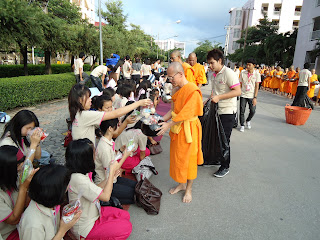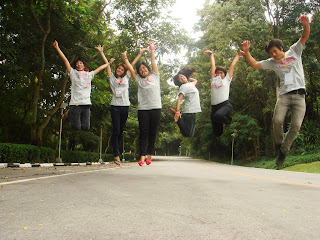Kitchana
Kaewkaen
Master degree
student of Physical Therapy program, Khon Kaen University
and president
of PTSUT 2010 E-mail: Ultranawin@gmail.com
The Physical Therapy Student Union of Thailand
(PTSUT) is a group of undergraduate
Physical Therapy students in 16 universities in Thailand. It was established in
1990 by four leading national Physical Therapy institutes; Mahidol University,
Khon Kaen University, Chiang Mai University and Rangsit University. It was first called the Physical Therapy
Student Center of Thailand (PTSCT) and was organized to provide a center for
extra curricular activities for Physical Therapy students.
The objectives of PTSUT are to function as a
non-political group uniting PT students throughout the country, to help each
other solve problems related to our profession, to be a coordination center for
information and distribution, to share our knowledge and experience with each
other and our communities by creating educational programs related to good
health and prevention methods.
Since our beginning in 1990, we have increased
our membership from 4 to 15 universities from all over Thailand. Our
institution members are Mahidol University, Khon Kaen University, Chiang Mai
University, Rangsit University, Huachiew Chalermprakiet University,
Chulalongkorn University, Srinakharinwirot University, Thammasat University,
Naresuan University, Christian University of Thailand, Prince of Songkla
University, Saint Louis College, Walailak University, University of Phayao and
Mae Fah Luang University. In 2010, PTSCT changed the name to PTSUT and 2011 we
added a new member, Burapha University. After changing the name, we promoted
more participation from the student members by strengthening the individual
groups in each institution. We share the same good goal – to be the best
Physical Therapists in the future.
PTSUT has 2 main committees; a
management board and an official board.
The committees act under the
PTSUT constitution. The management board has the authority to manage all
activities of PTSUT, which include
establishing, presenting, and managing policies and budget. The board also has
the responsibility for choosing which projects to do in each year. Each
institution has 2 representatives who serve on the management board. They are
the president and the vice president of the official board. The official boards
represent and organize PT students in their institutions.
2010 was the 1st year for
PTSUT to collaborate with well known groups throughout Thailand and other
countries. Within our country, PTSUT collaborated with the Health Science
Student Network which is composed of the Society of Medical Students of
Thailand (SMST), Dental Student Union of Thailand, Pharmacy Student Union of
Thailand (PSUT), The Nurse Students’ Association of Thailand (NSAT), Thailand
Public Health and Health Sciences Students Association. Internationally, PTSUT
collaborated with Asia Physical Therapy Student Association (APTSA). This
association is composed of 9 member countries around Asia; Taiwan, Japan, Hong
Kong, Korea, Singapore, Indonesia, Philippines, Malaysia and Thailand. After
that APTSA collaborated with World Wide Physical Therapy Student Network
(WWPTSN) and during this time WWPTSN made a group on facebook where Physical
Therapy students around the world can connect.
PTSUT holds many activities for the student
members. They are for the purpose of strengthening our confidence and sense of
pride in our profession. The most important activity is the Physical Therapy student camp. In 2010
more than 1,000 Physical Therapy students from universities around Thailand
joined this camp. It was held on 2 days and 1 night. The objectives of this
camp were bringing Physical Therapy students from each institution to meet and
work together and building the relationship between them.
The activities within the camp each year are up
to the host of the camp. For example, in
2010, there were many activities for students like a walk rally where students
from different institutions formed one group and then they walked to each
station to do an activity, such as thinking together to solve a professional
problem or playing a funny sport and game. There were activities for community
like teaching health care knowledge for the high school students, teaching
children to exercise, demonstrating a Physical Therapy breathing exercise by
using the BreatheMAX device which was developed by a Thai Physical Therapy
lecturer; using Thai dance as a treatment method; and others.
On the stage, we had a panel discussion about the
role of the Physical Therapy student in
solving professional problems and then letting students from the floor express
their opinion. At the end of last day, they sang a PTSUT song together. The
content of this song is about the relationship between us and how proud we are
to be Physical Therapy students.
PTSUT also
collaborates with a Health Science Student Network to do a one-day-long health
camp. We teach people in different communities. For example, in 2010, we held a
camp in Samutsakhon Province. Pharmacy students explained how to use medication
properly. Nursing students taught good health practices and did check-ups,
including blood pressure and blood tests. Dental students taught the importance
of good dental hygiene. Medical students
hosted the camp this year and made all the preparations for people who
would attend. Some medical students did diagnostic check ups under control of
medical teacher. Physical therapy students demonstrated disease prevention by
exercise.
The project which we collaborate with APTSA.
PTSUT works with APTSA as the
documentation department. Each year we send two student representatives
from Thailand to join the annual congress of APTSA. After that, the
representative comes back and reports on the meeting at the Physical Therapy
student camp and also through PTSUT media like facebook. APTSA sends
information online and PTSUT distributions it to student members. In 2011, after APTSA collaborated with World
Wide Physical Therapy Student Network (WWPTSN), PTSUT connected with two
friends from Germany. This is the first year in which
PTSUT was a host for students from another country. When they arrived, PTSUT
asked friends from Mahidol University to pick them up from the airport and let
them visit the Physical Therapy clinic in Bangkok. After that they visited Khon
Kaen University. We let them join student classes and observe clinical practice
at Srinagarind Hospital, Faculty of Medicine.
The other activities in PTSUT each year are up to
the president, but must have the
agreement of PTSUT committees. In 2010, PTSUT committees approved a lot
of projects. We had a theme of 'PTSUT in the Future' with an essay contest and
a magazine cover design contest. One objective was to understand and
incorporate the opinions and visions of the students for future development.
Awards were presented to the winners during the student camp.
In addition, we starting to use facebook, our
PTSUT magazine, and e-mail “ptsut_main@hotmail.com” to communicate with our
members and others. However the magazine had two weak points; it was only
published once a year and it was too expensive. So, we solved this problem by
doing a magazine online in 2012. An annual report describing the activities of
2010 and making suggestions for the following year was distributed to the
committees in each institution.
After Mr. Kitchana Kaewkaen served as president
of PTSUT for one year, 2010, he did his research to provide information for
future leaders. He presented it at the 3rd Thailand Physical Therapy
National Conference which was held by the Physical Therapy Association of
Thailand. The title of this research is “The satisfaction of Physical Therapy
students with the management board of Physical Therapy Student Union of
Thailand”. The objective was to determine the level of satisfaction of students
with the PTSUT activities and management. He used a questionnaire which
involved the PTSUT executive management. It asked the opinion of 362 1st
to 3rd year Physical Therapy students in 15 universities.
The data was collected and then analyzed by STATA
program. The results showed that most Physical Therapy students had a high
level of satisfaction in each category. Furthermore, the data showed there was
a statistical significance between the strategy of execution and attendance at
the Physical Therapy camp but not with the number of years of studying. Because
of the strong correlation between the satisfaction and the attendance at the
student camp, he recommended that communicating information about activities
may be the most important way to increase participation and knowledge about the
organization.
Physical Therapy Student Union of Thailand
(PTSUT) continues moving forward to do
activities with members and develop the potential of Physical Therapy
students in Thailand. We also work together helping each other solve
professional problems. Sometimes we encounter
many problems but we work as a team and learn together. We believe that
the current Physical Therapy students will be Physical Therapists in the
future. We hope they will continue to work as team members in their
professional lives.
Reference
1.Physical Therapy Student Union of Thailand
constitution, 2010.
2.Kitchana Kaewkaen. Physical Therapy Student
Union of Thailand annual report 2010.
3.Kitchana Kaewkaen. (2011). The satisfaction of
physical therapy students with the management board of Physical Therapy Student
Union of Thailand. In The 3rd Thailand Physical Therapy national
conference. Bangkok: Thailand.














